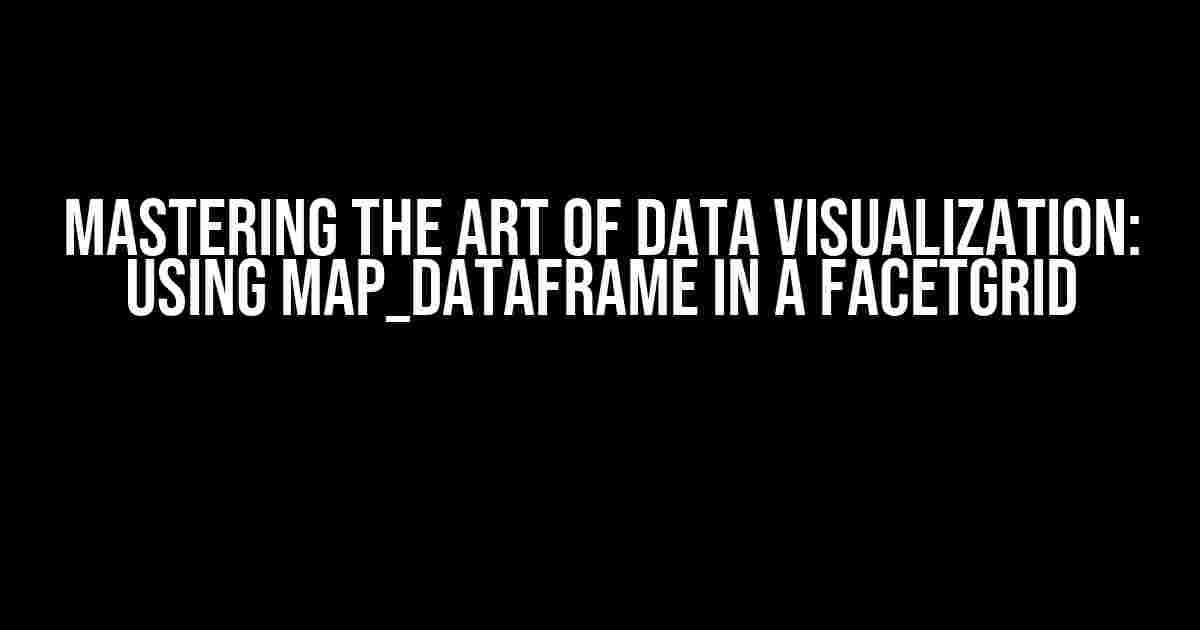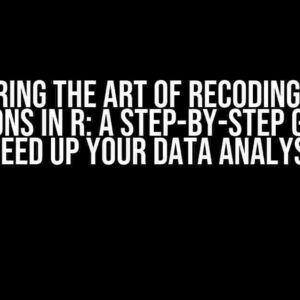Data visualization is an essential part of data analysis, and Seaborn’s FacetGrid is a powerful tool for creating informative and beautiful plots. However, did you know that you can take your visualizations to the next level by leveraging the power of `map_dataframe`? In this article, we’ll dive into the world of FacetGrid and explore how to use `map_dataframe` to create stunning and informative plots.
What is FacetGrid?
FacetGrid is a Seaborn function that allows you to create grids of plots based on one or more categorical variables. It’s a powerful tool for visualizing relationships between variables and identifying patterns in your data. With FacetGrid, you can create a wide range of plots, from simple scatter plots to complex heatmaps.
Why Use map_dataframe?
`map_dataframe` is a Seaborn function that allows you to apply a function to each element of a DataFrame or Series. When used in conjunction with FacetGrid, `map_dataframe` enables you to perform complex operations on your data and visualize the results in a beautiful and informative way.
So, why use `map_dataframe` in a FacetGrid? Here are a few reasons:
- Faster computation**: `map_dataframe` can significantly speed up computation by applying functions in parallel to each element of your DataFrame.
- Increased flexibility**: `map_dataframe` allows you to perform complex operations on your data, such as data cleaning, feature engineering, and feature scaling.
- Enhanced visualization**: By using `map_dataframe` to perform operations on your data, you can create more informative and visually appealing plots.
Basic Usage of map_dataframe in FacetGrid
To get started with using `map_dataframe` in a FacetGrid, you’ll need to import Seaborn and load your data.
import seaborn as sns
import matplotlib.pyplot as plt
# Load the tips dataset
tips = sns.load_dataset('tips')
Next, create a FacetGrid object and specify the column you want to facet by.
# Create a FacetGrid object g = sns.FacetGrid(tips, col="sex", hue="smoker")
Now, you can use `map_dataframe` to apply a function to each element of your DataFrame. For example, let’s say you want to calculate the mean tip amount for each group.
# Apply a function to each element of the DataFrame g.map_dataframe(lambda x: x['tip'].mean())
This code will calculate the mean tip amount for each group and display the result in a FacetGrid plot.
Advanced Usage of map_dataframe in FacetGrid
While the basic usage of `map_dataframe` is straightforward, you can also use it to perform more complex operations on your data.
Data Cleaning
One common task in data analysis is data cleaning. `map_dataframe` can be used to perform data cleaning operations, such as removing missing values or handling outliers.
# Remove missing values g.map_dataframe(lambda x: x.dropna())
Feature Engineering
Another common task is feature engineering. `map_dataframe` can be used to create new features or transform existing ones.
# Create a new feature g.map_dataframe(lambda x: x['total_bill'] / x['size'])
Feature Scaling
Feature scaling is an essential step in many machine learning algorithms. `map_dataframe` can be used to scale features using techniques such as standardization or normalization.
# Standardize features from sklearn.preprocessing import StandardScaler scaler = StandardScaler() g.map_dataframe(lambda x: scaler.fit_transform(x[['total_bill', 'tip']]))
Common Use Cases for map_dataframe in FacetGrid
Now that you’ve seen the basics of using `map_dataframe` in a FacetGrid, let’s explore some common use cases.
Groupby Operations
One common use case for `map_dataframe` is groupby operations. For example, you can use `map_dataframe` to calculate the mean, median, or standard deviation of a group.
# Calculate the mean of a group g.map_dataframe(lambda x: x['tip'].mean())
Data Transformation
Another use case is data transformation. For example, you can use `map_dataframe` to log-transform a variable or perform a square root transformation.
# Log-transform a variable g.map_dataframe(lambda x: np.log(x['total_bill']))
Visualization
Finally, `map_dataframe` can be used to create stunning and informative visualizations. For example, you can use `map_dataframe` to create a heatmap of correlations between variables.
# Create a heatmap of correlations g.map_dataframe(lambda x: x.corr())
Best Practices for Using map_dataframe in FacetGrid
Now that you’ve seen the power of using `map_dataframe` in a FacetGrid, here are some best practices to keep in mind.
1. Keep it simple**: While `map_dataframe` is a powerful tool, it’s essential to keep your code simple and readable. Avoid using complex functions or operations that are difficult to understand.
2. Use built-in functions**: Seaborn and Pandas provide many built-in functions that can be used with `map_dataframe`. Take advantage of these functions to simplify your code and improve performance.
3. Avoid slow operations**: `map_dataframe` can be slow for large datasets. Avoid using operations that are computationally expensive or slow.
4. Visualize your results**: One of the most important aspects of using `map_dataframe` is visualizing your results. Take the time to create informative and visually appealing plots that convey your findings.
Conclusion
In this article, we’ve explored the power of using `map_dataframe` in a FacetGrid. By applying functions to each element of your DataFrame, you can perform complex operations and create stunning visualizations. Remember to keep it simple, use built-in functions, avoid slow operations, and visualize your results. With practice and patience, you’ll become a master of Seaborn’s FacetGrid and `map_dataframe`.
| Function | Description |
|---|---|
| map_dataframe | Applies a function to each element of a DataFrame or Series |
| FacetGrid | Creates a grid of plots based on one or more categorical variables |
| groupby | Groups a DataFrame by one or more categorical variables |
| mean | Calculates the mean of a group |
| corr | Calculates the correlation between variables |
Now, go forth and create some amazing visualizations with `map_dataframe` and FacetGrid!
Frequently Asked Question
Get ready to navigate the world of data visualization with ease! If you’re struggling to use map_dataframe in a FacetGrid, we’ve got you covered. Check out these frequently asked questions and level up your data game!
What is the main purpose of using map_dataframe in a FacetGrid?
The map_dataframe function in a FacetGrid allows you to apply a function to each facet of the grid, making it an efficient way to visualize and explore large datasets. It’s particularly useful when you want to perform the same operation on each facet, such as plotting a regression line or adding a customized annotation.
How do I specify the function to be applied to each facet using map_dataframe?
To specify the function, simply pass it as an argument to the map_dataframe method. For example, if you want to plot a histogram on each facet, you would use `g.map_dataframe(sns.histplot, x=’column_name’)`, where `g` is your FacetGrid object, `sns` is the seaborn library, and `x` is the column you want to plot.
Can I use map_dataframe with other Seaborn visualization tools, such as lineplot or scatterplot?
Absolutely! map_dataframe is not limited to histograms. You can use it with other Seaborn visualization tools, such as lineplot, scatterplot, or even custom functions. Just make sure to pass the correct function and arguments to the map_dataframe method.
How do I customize the appearance of the plots generated by map_dataframe?
You can customize the appearance of the plots by using various options available in the Seaborn visualization functions. For example, you can change the color palette, add axis labels, or modify the plot title. You can also use matplotlib’s axes-level functions to further customize the plots.
What are some common use cases for using map_dataframe in a FacetGrid?
Some common use cases for using map_dataframe in a FacetGrid include visualizing correlations between variables, exploring distributions of variables across different categories, and creating small multiples for categorical data. It’s a powerful tool for data exploration and visualization!


